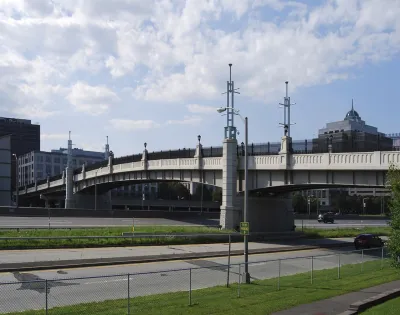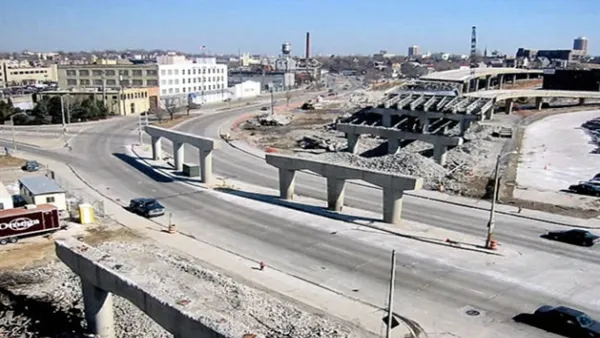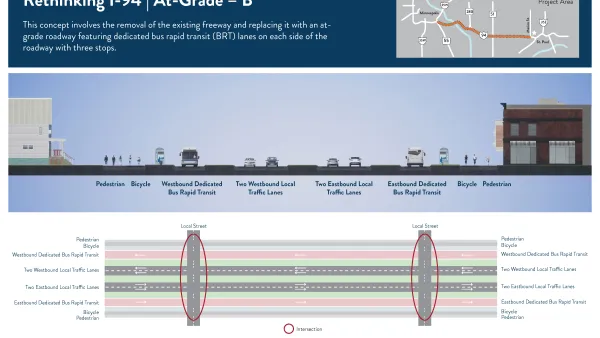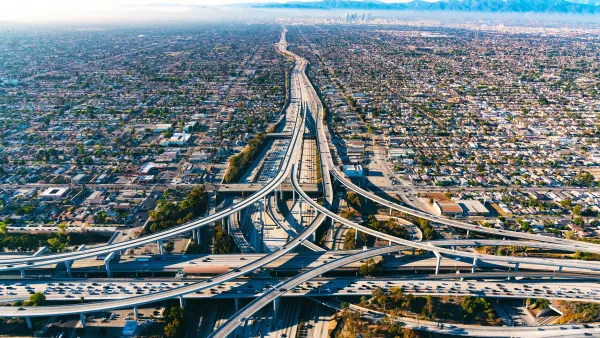Finding full-scale highway removal nearly impossible, advocates in the New York state capital turn to creative workarounds to reconnect the city to the Hudson River.

Built during the highway craze of the 1960s (which arguably continues today), the six-lane Interstate 787 in Albany lets commuters "make a swift exit to outlying suburbs or points downstate," but also blocks access to the city's waterfront on the Hudson River. Like other urban highways, writes Mike De Socio, I-787 "also devoured about 100 acres of downtown Albany, bulldozing homes and businesses, cutting the city off from the riverfront and walling off some of its poorest neighborhoods."
Yet for decades, efforts to remove parts of the highway have failed, "[s]o now the city is chasing a number of offbeat workarounds." Proposals range from an elevated, High Line-style park to "digging a canal through downtown Albany, in an effort to bring the river back into the city."
So far, the only project that has broken ground is the Albany Skyway, "an on-ramp-turned-linear-park due to open next year." According to Matthew Peter, executive director of the Albany Parking Authority and one of the driving forces behind the project, says "the Skyway has moved forward where other proposals haven’t because it represented a compromise between tearing down the entire highway and, well, doing nothing." With a $13 million budget, the Skyway requires much less investment than full-scale highway removal. Peter "believes that reclaiming the ramp for human-scale pursuits can kick off a gradual process of rethinking, and eventually removing, the elevated section of 787."
Workarounds like this are necessary in part because they allow the city to take initiative without state agencies. "New York State not only controls the highway itself, but also the capital complex whose workers depend on it." But "[w]ith the highway nearing the end of its planned lifespan" and highway removal gaining support in cities around the country, city and state leaders will have to decide what the future holds for Albany's waterfront. Meanwhile, "infrastructure funds from the Biden administration have inspired fresh hope among advocates for undoing the ill effects of 1960s-era urban thoroughfares."
FULL STORY: Finding a Creative Way Around a Bad Highway

Analysis: Cybertruck Fatality Rate Far Exceeds That of Ford Pinto
The Tesla Cybertruck was recalled seven times last year.

National Parks Layoffs Will Cause Communities to Lose Billions
Thousands of essential park workers were laid off this week, just before the busy spring break season.

Retro-silient?: America’s First “Eco-burb,” The Woodlands Turns 50
A master-planned community north of Houston offers lessons on green infrastructure and resilient design, but falls short of its founder’s lofty affordability and walkability goals.

Test News Post 1
This is a summary

Analysis: Cybertruck Fatality Rate Far Exceeds That of Ford Pinto
The Tesla Cybertruck was recalled seven times last year.

Test News Headline 46
Test for the image on the front page.
Urban Design for Planners 1: Software Tools
This six-course series explores essential urban design concepts using open source software and equips planners with the tools they need to participate fully in the urban design process.
Planning for Universal Design
Learn the tools for implementing Universal Design in planning regulations.
EMC Planning Group, Inc.
Planetizen
Planetizen
Mpact (formerly Rail~Volution)
Great Falls Development Authority, Inc.
HUDs Office of Policy Development and Research
NYU Wagner Graduate School of Public Service




























